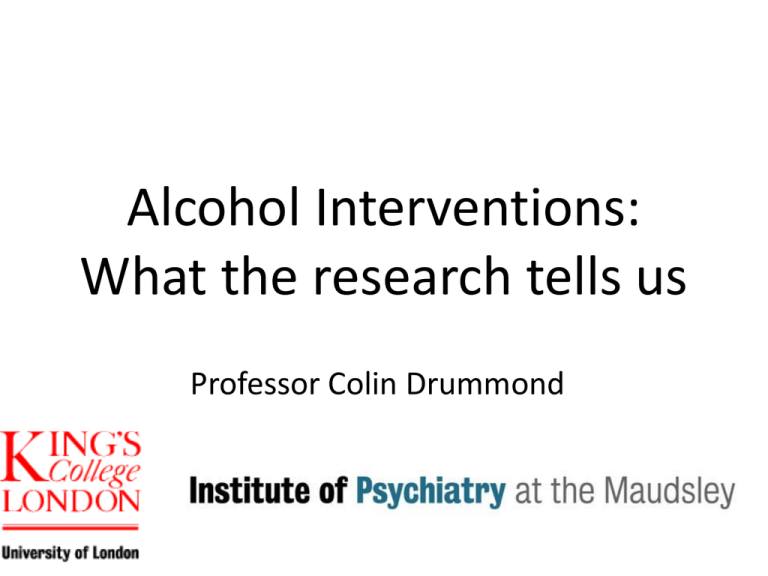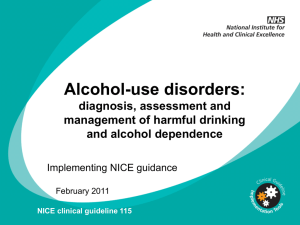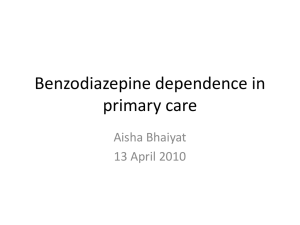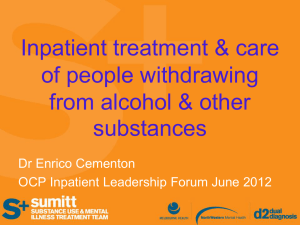What the research tells us
advertisement

Alcohol Interventions: What the research tells us Professor Colin Drummond Alcohol use disorders: prevalence Drummond et al., 2005 • 26% of the adult population have an alcohol use disorder (AUD) • Includes 38% of men & 16% of women aged 16-64 • 23% of the adult population are hazardous or harmful alcohol users (7.1 million people in England) • 21% of men and 9% of women engage in binge drinking • Prevalence of alcohol dependence is 3.6% overall, 6% among men, and 2% among women (1.1 million people in England) Alcohol dependence is considerably more prevalent than drug abuse Alcohol Needs Assessment Research Project, 2005 “The habit of drunkenness is a disease of the mind” NICE Guidance 2010-11 • Alcohol use disorders – Preventing harmful drinking (PH24) – Diagnosis and clinical management of alcohol related physical complications (CG100) – Diagnosis, assessment and management of harmful drinking and alcohol dependence (CG) • Related guidance – Psychiatric comorbidity (CG) – Complex pregnancies (CG) NICE Guidance 2010-11 • Alcohol use disorders – Preventing harmful drinking (PH24) – Diagnosis and clinical management of alcohol related physical complications (CG100) – Diagnosis, assessment and management of harmful drinking and alcohol dependence (CG) • Related guidance – Psychiatric comorbidity (CG) – Complex pregnancies (CG) Preventing harmful drinking – evidence relevant to interventions • AUDIT high sensitivity and specificity • Laboratory markers poor screening tools • Brief interventions effective (27 systematic reviews) • Brief advice as effective as extended brief intervention ~ brief more cost effective • Brief interventions less effective in alcohol dependence than hazardous/harmful drinkers • Most evidence in primary care, limited for acute care & CJS settings Preventing harmful drinking (PH24) • All NHS professionals and non-NHS • Routine alcohol screening – Universal – Targeted “if not feasible” • • • • • Validated screening tool (AUDIT, FAST etc) Don’t use biological markers Structured brief advice- all hazardous/harmful Extended brief- non-responders Referral of moderate/severe alcohol dependence/non-responders to brief interventions Clinical management • Unplanned withdrawal: – Admit high risk, vulnerable and under 16s – Symptom triggered regime more cost effective – Benzodiazepine or carbamazepine – CIWA monitoring • Wernicke’s encephalopathy – Oral thiamine for most – Parenteral for malnourished, liver disease and in AED or admitted for acute illness or injury Management of harmful drinking and alcohol dependence • • • • • • • • Identification and assessment Care coordination Settings Assisted withdrawal Psychosocial interventions Pharmacological interventions Comorbidity Children and young people Identification and assessment • Competence • Motivational interviewing • Alcohol misuse, dependence, problems, risk, need for assisted withdrawal • Formal assessment tools (AUDIT, SADQ, LDQ, APQ, CIWA, MMSE) • Treatment goals • Children and young people Care pathway – case identification and possible diagnosis for adults Screen (PAT, FAST, SASQ etc.) indicates possible alcohol use disorder Administer: AUDIT AUDIT < 8 AUDIT 8–15 AUDIT 16–19 AUDIT 20+ Hazardous drinking Harmful drinking Probable alcohol dependence Brief intervention Extended brief intervention(s) Referral to specialist assessment/withdraw al assessment Review of progress Referral to specialist assessment where no improve maintained Consider Tier 2 interventions Consider Tier 2 or 3 interventions/ immediate withdrawal assessment for acute inpatients settings and prisons Interventions: delivery and setting • • • • • • Competence, manuals, supervision Care coordination Case management – alcohol dependence Stepped care and ACT Inpatient withdrawal management Structured intensive community programme – Moderate severe dependence, social support, complex needs • Residential rehabilitation – Moderate severe dependence AND homeless – 3 months Interventions • Harmful/mild dependence – CBT, BT, Social Network therapy – BCT – Non-responders: offer acamprosate, naltrexone plus psychosocial • Moderate/severe dependence – – – – – Assisted withdrawal Intensive community programme Acamprosate or naltrexone plus CBT, BT, SNT, BCT Disulfiram (second line, suitability/preference) • Children and young people under 18 – Inpatient for withdrawal – CBT, multi-component programmes – Acamprosate or naltrexone (second line 16-18 only) • Families and carers – Assessment and intervention in their own right Association between baseline severity and effect size in naltrexone versus placebo trials (logRR) Assisted withdrawal • Threshold for assessment: >20 AUDIT >15 units/day • Community based withdrawal programme - most • Inpatient assisted withdrawal – >30 SADQ, fits or DTs – OR 15-30 plus benzodiazepine, mental or physical comorbidity, learning disability, cognitive impairment – Lower threshold for homeless, older, younger, pregnancy, homeless • Regimes – Community: fixed dose – Inpatient: fixed dose or symptom triggered AUDIT AUDIT > 20 Consider need for alcohol withdrawal AUDIT < 20 Outcome of assessment SADQ < 15 Typical drinks per day < 15 SADQ 15–30 Typical drinks per day < 30 units Absence of comorbid features SADQ ≥ 30 Typical drinks per day ≥ 30 units Comorbid features present Consider Tier 2 or 3 interventions: Outpatient (Tier 3 interventions): Inpatient (Tier 4 interventions): Psychological and pharmacological interventions Comprehensive assessment where comorbid features present Assisted alcohol withdrawal Assisted alcohol withdrawal Gap between need and access (PSUR) by region











